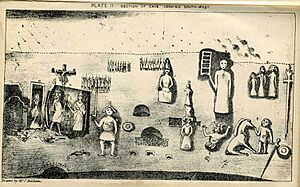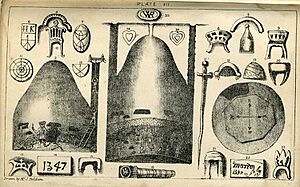Royston Cave facts for kids
Royston Cave is a mysterious underground room located in Royston, England. It's hidden beneath a busy crossroads where two old roads, Ermine Street and Icknield Way, meet. This unique cave is protected as an important historical site and a special building.
People have many ideas about who built the cave and why. Some think it was used by the Knights Templar, a famous group of medieval knights, but there isn't strong proof for this. Other ideas suggest it was a secret meeting place for Freemasons, a prison, or a quiet cell for a religious person called an anchorite. However, none of these theories have enough solid evidence to be fully accepted by the people who look after the cave today.
The cave is shaped like a bell, carved right into the chalk rock. It's about 8 meters (26 feet) tall and 5 meters (17 feet) wide. What makes Royston Cave truly special are the many old carvings on its walls. You won't find anything quite like them anywhere else in Britain! Some of the carvings are thought to show famous saints like St. Catherine, St. Lawrence, and St. Christopher.
Contents
What Are the Main Ideas About the Cave?
Royston Cave has sparked lots of guesses about its past, but it's still hard to know for sure how it started or what it was used for.
Knights Templar Connection
Some people think the cave might have been used by the Knights Templar. These were powerful religious knights who existed a long time ago, before their group was ended in 1312. There were ideas that the cave might have had two floors, with a wooden floor dividing it, but the evidence for this is very small.
One carving shows two figures close together. Some believe this might be a symbol of the Templars: two knights riding one horse. But this carving has been fixed in modern times, so we can't be certain. Also, experts like Nikolaus Pevsner thought the carvings were made much later, between the 1300s and 1600s. The knights in the carvings wear full plate armor, which became common long after the Templars were gone. This makes it unlikely they carved them.
Other Theories About Its Use
- Early Freemason's Lodge: Another idea is that it was a meeting place for early Freemasons.
- Augustinian Store House: Some believe it was used by Augustinian monks from a nearby church. They might have needed a cool place to store food or a small chapel for prayers. The idea that it was a secret meeting place for Catholics during the 1500s doesn't have much support.
- Private Chapel: It could have been a private chapel for an important local person.
- Wayside Hermitage: Or perhaps it was a quiet place for a religious person, like a hermit, to live and pray.
How Was the Cave Found Again?
Even though we don't know how the cave began, we know exactly when it was found again! In August 1742, a worker was digging a hole in the Butter Market to put in a new bench. He found a buried millstone and started digging around it to get it out. That's when he discovered a shaft leading down into the chalk.
When they first found it, the cave was more than half-filled with dirt. People thought there must be treasure buried inside! So, they removed many cartloads of soil. But all they found were a few old bones and pieces of pottery. Today, archaeologists would love to study that soil, as it could tell us so much. The entrance we use today isn't the original one; a new passage was dug in 1790.
The cave is located where two very old roads meet: the Icknield Way, an ancient path used since the Iron Age, and Ermine Street, a Roman road.
The Amazing Carvings
It's believed that the sculptures on the walls were once brightly colored, but most of that color has faded away now. In the mid-1800s, a man named Joseph Beldam could still see the yellow dress of St. Catherine and the red colors of the Holy Family.
Most of the carvings show religious scenes and figures, like the Crucifixion and various saints. For example, St. Lawrence is shown holding the grill he was tortured on. A figure wearing a crown and holding a wheel seems to be St. Catherine. A large figure with a staff and a child on his shoulder represents St. Christopher. There are also many small holes, often right below the carvings. These were probably used to hold candles or lamps, which would have lit up the amazing artwork.
Keeping the Cave Safe
In 2010, experts found that damp conditions in the cave were causing problems. Tiny insect larvae and worms were damaging the walls and carvings! So, work began to fix this. By August 2014, the good news was that the chalk-eating worms were gone.
James Robinson, the cave manager, explained that they couldn't use chemicals because the cave is open to the public. Instead, they removed the soil and debris at the bottom of the cave, especially on the step below the carvings. Without their food, the worms soon moved away. They also fixed water pipes, as water leaking into the cave had caused cracks in the carvings. Even traffic vibrations from the road above could cause problems in the future.
Despite all the hard work, in November 2018, the cave was added to Historic England's "Heritage at Risk" list. This means it still needs special care to protect it for the future.




